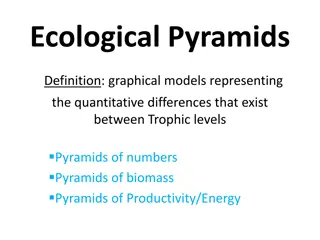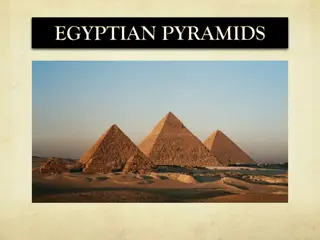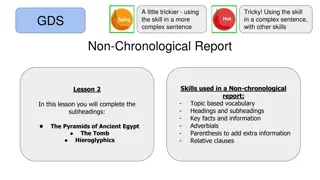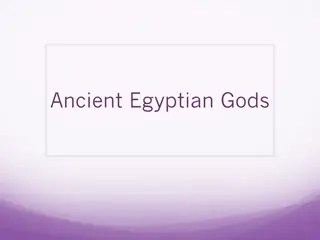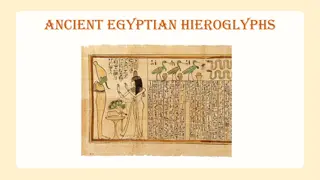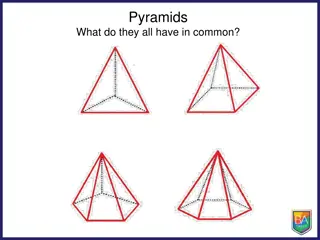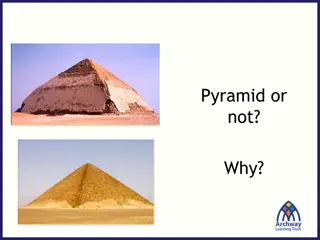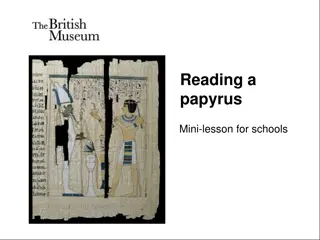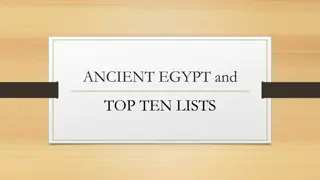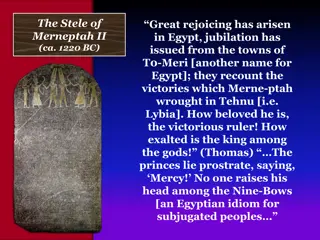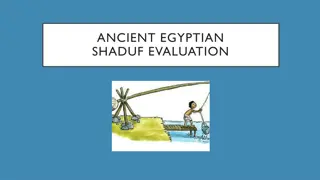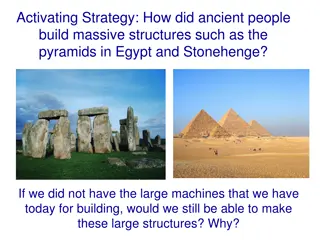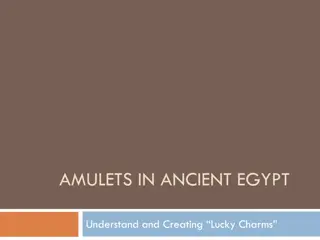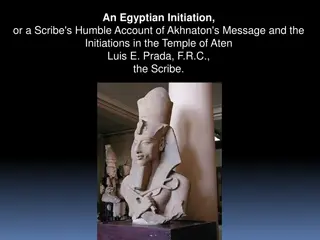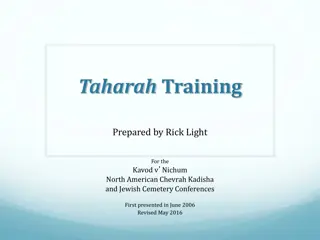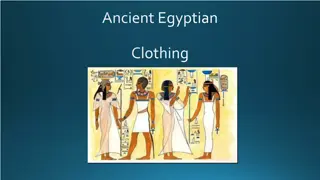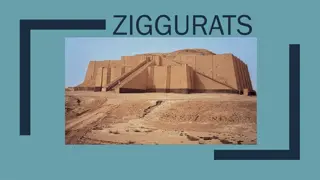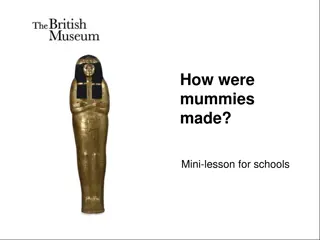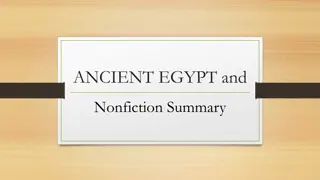Unveiling the Mysteries of Ancient Egyptian Burial Practices and Pyramids
Delve into the ancient civilization of Egypt that lasted over 3000 years, leaving behind monumental structures like the Pyramids. Explore the evolution of Egyptian burial practices from Mastabas to Pyramids, reflecting beliefs in immortality and the afterlife. Discover why Pharaohs were buried in elaborate tombs and how the Pyramids symbolized the journey of the human spirit towards the gods.
Download Presentation

Please find below an Image/Link to download the presentation.
The content on the website is provided AS IS for your information and personal use only. It may not be sold, licensed, or shared on other websites without obtaining consent from the author. Download presentation by click this link. If you encounter any issues during the download, it is possible that the publisher has removed the file from their server.
E N D
Presentation Transcript
Mysteries of Egypt "To speak the name of the dead is to make him live again" Pyramids; CMC PCD 2001-301-068
Ancient Egypt civilization lasted over 3000 years. Egyptian monuments have been around so long that their monuments were ancient even in Greek and Roman times . but one key question has always loomed: how were the pyramids built?
The Pyramids are one of the Seven Wonders of the Ancient World. Decorating the Nile waterfront they loom over passing boats. They are the lasting reminders of the Pharaohs that once ruled Egypt and of the power that the nation had. There are More than eighty (80) pyramids were built around the Nile from 1600 - 2700 BC
How did the Egyptian burial practices evolve? Mastabas Mummification 3. Pyramids 4. Valley of the Kings 1. 2. Pyramids; CMC PCD 2001-301-068
MASTABAS Mastaba tombs were low rectangular brick or stone structures. Like the pyramids, they were built on the west side of the Nile (symbol of death, where the sun falls into the underworld). In the mastabas, lavish tombs with all necessary possessions would be prepared for the Phaorahs The pyramids evolved from the mastabas
BURIAL TOMBS: four-sided stone structure that symbolizes the sacred mountain, humanity s universal striving to reach the heavens. PURPOSE: because the Pharaoh was viewed as a god, he lived in the spirit world with the gods. Upon death, he had to be able to return to his body on earth, and required a tomb where his body would be preserved and surrounded by materials he would need whenever his spirit returned to his body IMMORTALITY: the ancient belief in raising the human spirit towards the gods is the quintessential purpose behind the construction of pyramids
The Pyramids were built on the west side of the Nile, as the sun sets in the west. This represented the cycle of life (east = rebirth); west= death).
Valley of the Kings Beginning with the 18th dynasty and ending with the 20th, the kings abandoned the Memphis area and built their tombs in Thebes. Also abandoned were the pyramid style tombs. Most of the tombs were cut into the limestone following a similar pattern: three corridors, an antechamber and a sunken sarcophagus chamber. These catacombs were harder to rob and were more easily concealed. Construction usually lasted six years, beginning with the new reign. The text in the tombs are from the Book of the Dead, the Book of the Gates and the Book of the Underworld. View of the central East Valley, showing area around KV62
Imhotep: The Step Pyramid at Saqqara During the early Old Kingdom (2680 BCE), King Djoser commissioned Imhotep to build him a memorial tomb that would remind future generations of his brilliance and power Imhotep took the idea of the mastabas and stacked six of them one on top of the other > creating a stairway to Heaven This became the world s first building made completely of stone Steps in the pyramid were to enable the pharaoh to take his place among the star gods
The pyramids evolved from that point Later designers were to smooth out the edges Inner burial chambers and hidden passages and tombs were built within the pyramids The pyramids have mathematical dimensions that have stupefied later societies
Pharaoh Sneferu 2575-2551 BCE) (father to Khufu) Most enthusiastic builder of pyramids building at least four pyramids during his reign At Dashur, a pyramid was built with 2 entrances (north and west) However the angle of the first was too sharp and collapsed To save the other, the angle of the walls was changed, leaving a bent appearance This is called the Bent Pyramid !
The Red Pyramid was the first to achieve the perfect pyramid shape Stripped from its limestone casing, this pyramid reveals the reddish sandstone used to build most of its core. Its Ancient Egyptian name was "The Shining One". the Red Pyramid at Dashur has the second largest base of any pyramid in Egypt
Giza Pyramid: The Great Pyramid The pyramids at Giza photographed in December of 2003 using a Canon D60 digital camera and Canon 28-105mm lens set to 38mm (1/125th second, f4.5, ISO 100) Built under the rule of Khufu (Cheops in Greek) outside of Cairo (Giza) Belief that Pharaoh would join the sun-god Ra as Ra made his daily journey by boat across the sky. Thus Khufu would need a pyramid shaped like a sunburst, so he could climb on the rays of the sun to join Re Still remains the largest stone building on Earth
A meridian running through the pyramids divides the continents and oceans into two equal halves
The Pyramid lies in the exact center of all the land area of the world, dividing the earth's land mass into approximately equal quarters. The north-south axis is the longest land meridian, and the east-west axis is the longest land parallel on the globe. There is obviously only one place that these longest land-lines of the terrestrial earth can cross, and it is at the Great Pyramid!
Pyramid of Giza: Look at the Stats! Original entrance of the Great Pyramid. Total of 2.3 2.6 million blocks of limestone were cut out of the quarries, dressed and transported and fitted together Each block weighs average 2.5 tons 15 tons 2.5 tons= approximately 25 refrigerators seam between blocks were very fine, about 1 mm on all 6 sides Only error of less than 0.1% in construction of Great Pyramid Estimated Construction: 20- 80 years
Great Pyramids of Giza: Size Stats 920 meters around Nearly 10 football fields could fit within the base. The area of the base is also equal to about seven city blocks in New York City or about 13 acres.
The rocky structure where the pyramids stand had to be leveled (south east corner is just 1/3 inch higher than northwest corner! Great Pyramid is a sundial. The shadow fell on pavements and the pavements were marked with the day of the year and the hour of the day. Great Pyramid is a giant calendar. The Egyptians could use it to measure the length of a year to three decimal places 365.24
Did you know? The surface of blocks did not crack along layers after thousands of years of exposure to wind and sun The casing stones, 144,000 in all, were so brilliant that they could literally be seen from the mountains of Israel hundreds of miles away. On bright mornings and late afternoons, sunlight reflected by this vast mirrored surface of 5-1/4 acres distinguished the Pyramid as being visible from the moon. Priests of Pharoh Khufu convinced him to pay for all the bills of the Great Pyramid!
In the Chamber In the heart of the burial chamber, you'll be 20 m (66 ft) beneath the foundation with over 6 million tons of stone piled above you! Burial chamber filled with riches for Pharaoh to take into afterlife Inside the pyramids there were false doors, staircases and corridors In the King s Chamber of the Great Pyramid, laid a stone coffin that contained nothing! King Khufu had never been placed in his burial place!
Pi? The area of the base of the pyramid divided by twice its height gives the figure of pie (3.14) The height of the Pyramid's apex is 5,812.98 inches, and each side is 9,131 inches from corner to corner (in a straight line). If the circumference of the Pyramid is divided by twice its height (the diameter of a circle is twice the radius), the result is 3.14159, which just happens to be pi. Incredibly, this calculation is accurate to six digits. So the Pyramid is a square circle, and thus pi was designed into it 4,600 years ago. Pi is demonstrated many times throughout the Pyramid. pi
QUESTIONS Blocks of granite moved from Aswan (950 km away) each weighing 53.5 tons How did people get out of pyramids (building trap doors / secret corridors? No markings inside the pyramids from torches? How did they transport the stones? Ramps? Boats? Lifting? Who built these pyramids?
Theories: Who really built the pyramids? Slaves (100 000 or 200 000? ) Hebrew Slaves Farmers (during annual flooding) Stars Aliens How long? Transportation Methods? Limestone from quarries floated to base of pyramids Graffiti / Drawings Articles: 1) Heave Ho 2) Chariots Still Crash 3) Pouring a Pyramid
oldest and longest stone sculpture from the Old Kingdom lion s body and a human head, it represents Ra-Horakhtv, a form of the powerful sun god, and is the incarnation of royal power and the protector of the temple doors. The face of the Great Sphinx is believed to be that of Chephren, the fourth-dynasty pharaoh who built the second-largest pyramid in the Giza triad. Carved out of a natural limestone outcrop, the Sphinx is 19.8 metres (65 feet) high and 73.2 metres (240 feet) long. It is located a short distance from the Great Pyramid. Great Sphinx Sphinx; CMC PCD 2001-303-029
The Legacies of the Pyramids LOUVRE, France


